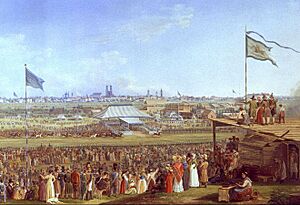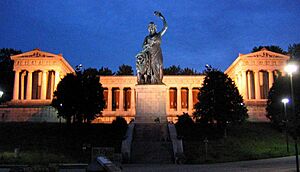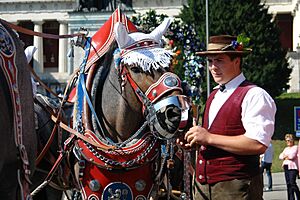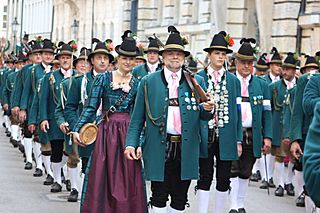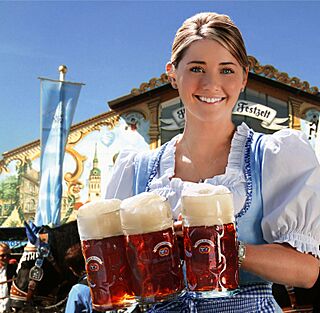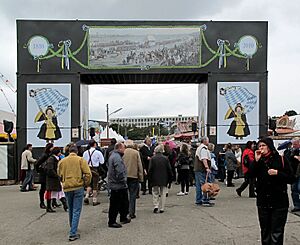Oktoberfest facts for kids
Quick facts for kids Oktoberfest |
|
|---|---|
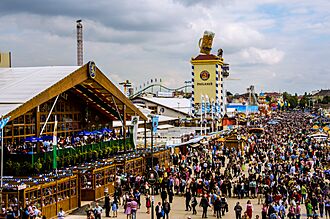
The festival grounds, called Theresienwiese, in 2013
|
|
| Observed by | Munich, Germany |
| Type | Cultural festival and funfair |
| Celebrations | Parades, music, Bavarian food and funfair rides |
| 2024 date | 21 September |
| 2025 date | 20 September |
| Frequency | Annual |
| Related to | Oktoberfest celebrations |
Oktoberfest is the world's largest folk festival, also known as a Volksfest. It's a huge funfair and cultural celebration held every year in Munich, Germany. The festival takes place on a large open space called the Theresienwiese. It usually starts in mid-September and ends on the first Sunday of October.
Every year, millions of people from all over the world come to visit. They enjoy exciting amusement rides, fun games, and traditional Bavarian food. While adults can try the special Oktoberfest beer, there's fun for the whole family. In 2023, a record 7.2 million people attended the festival.
The very first Oktoberfest was held way back on October 12, 1810. Over its long history, the festival has only been cancelled a few times, most recently in 2020 and 2021 because of the worldwide pandemic.
Contents
The Story of Oktoberfest
A Royal Wedding Party
The first Oktoberfest wasn't a beer festival at all! It was a public celebration for the wedding of Crown Prince Ludwig of Bavaria (who would later become King Ludwig I) and Princess Therese of Saxe-Hildburghausen. The citizens of Munich were invited to celebrate on the fields in front of the city gates.
These fields were named Theresienwiese ("Therese's Meadow") to honor the princess, and the name is still used today. The main event of the first festival was a big horse race. The party was so much fun that everyone decided to do it again the next year, and that's how the Oktoberfest tradition was born.
Growing Bigger and Better
As the years went by, the festival grew and added new attractions.
- 1811 – An agricultural show was added to show off the best of Bavarian farming.
- 1814 – Fun activities like swings and climbing poles were introduced.
- 1818 – Carnival booths appeared, where people could win prizes.
In 1819, the city of Munich took over running the festival and decided it should happen every single year. Later in the century, the festival was moved to late September to enjoy the warmer weather.
Since 1850, a giant bronze statue called the Bavaria statue has watched over the festival grounds. It stands in front of a famous building called the Ruhmeshalle, or Hall of Fame.
By the end of the 1800s, the festival started to look more like it does today. Electric lights were installed, stalls began selling famous German sausages called bratwurst, and small drink stands were replaced by the huge beer halls that are still used.
The Festival in Modern Times
The 20th century brought many changes. In 1910, Oktoberfest celebrated its 100th birthday. However, the festival had to be cancelled several times because of wars and other difficult times in Europe.
During a challenging period in German history from 1933 to 1945, the festival was used for political messages, and some people were unfairly not allowed to work there. The festival was paused during World War II.
In 1980, a very sad and violent incident happened near the main entrance. After this, security was made much stronger to help keep all visitors safe.
In 2010, Oktoberfest celebrated its 200th anniversary with a special historical festival. The 2025 festival was briefly paused on October 1st due to a safety concern in the city, but it reopened to continue the celebration.
Famous Oktoberfest Traditions
The Grand Opening Parade
The festival doesn't just start—it begins with a big parade! This tradition started in 1887. Today, the parade is led by the mascot of Munich, the Münchner Kindl (Munich Child), who is usually a young woman in a monk's robe riding a horse. The Mayor of Munich follows in a special carriage. The parade also includes decorated horse-drawn wagons from the breweries and lively music bands.
"O'zapft is!": The Festival Begins
After the parade, at exactly 12:00 PM, the Mayor of Munich goes to the Schottenhamel tent for the opening ceremony. The mayor taps the first keg of Oktoberfest beer and shouts "O'zapft is!", which is Bavarian for "It is tapped!"
This officially starts the festival. A 12-gun salute is fired, which is the signal for all the other tents to start serving drinks and food. People always watch to see how many hits it takes the mayor to tap the keg. The record is just two!
The Costume Parade
On the first Sunday of the festival, there is another amazing parade called the Costume and Riflemen Parade. It's one of the largest parades of its kind in the world.
About 8,000 people walk a 7-kilometer route through Munich. They wear beautiful traditional costumes, like the famous Dirndl dresses and Lederhosen (leather shorts). The parade includes marching bands, flag-wavers, and groups from all over Bavaria and other parts of Europe.
Inside the Festival
The Giant Beer Tents
The heart of Oktoberfest is its huge tents. There are 14 large tents and many smaller ones. These aren't just simple tents; they are massive wooden structures that can hold thousands of people. Each of the large tents is run by one of Munich's six famous breweries. Inside, you'll find long wooden tables, live brass bands playing traditional music, and people enjoying the festive atmosphere.
Here are some of the famous large tents:
| Tent name | Brewery | Fun Fact |
|---|---|---|
| Marstall | Spaten-Franziskaner-Bräu | One of the newer tents, known for its horse-themed decorations. |
| Armbrustschützenzelt | Paulaner | Its name means "Crossbowman's Tent," and it hosts a crossbow competition. |
| Hofbräu-Festzelt | Hofbräu München | Very popular with visitors from all over the world. |
| Hacker-Festzelt | Hacker-Pschorr | Known as "Heaven of the Bavarians" because of its beautiful painted ceiling. |
| Schottenhamel | Spaten-Franziskaner-Bräu | This is where the mayor taps the first keg to open the festival. |
| Winzerer Fähndl | Paulaner | Easy to spot because of its huge tower with a giant beer mug on top. |
| Augustiner-Festhalle | Augustiner Bräu | A family-friendly tent that serves beer from traditional wooden barrels. |
| Ochsenbraterei | Spaten | Famous for its delicious roasted ox dishes. |
| Fischer-Vroni | Augustiner | Known for a special dish of fish grilled on a stick, called Steckerlfisch. |
Special Oktoberfest Beer
Only special beer that is brewed in the city of Munich can be served at Oktoberfest. This beer must follow a very old German quality rule called the Reinheitsgebot. This special festival beer is called "Oktoberfestbier".
Only six breweries are allowed to make it:
- Augustiner Bräu
- Hacker-Pschorr
- Löwenbräu
- Paulaner
- Spaten
- Hofbräu München
The "Oide Wiesn": A Trip to the Past
For the 200th anniversary in 2010, a special area called the Oide Wiesn (Bavarian for "Old Fairground") was created. It was so popular that it's now a regular part of the festival.
The Oide Wiesn is like stepping back in time. It has old-fashioned rides, like historic carousels and swings. There are also tents with traditional music and dancing, and a museum tent that shows the history of Oktoberfest. It's a quieter, more traditional part of the festival that families often enjoy.
Oktoberfest Around the World
The Munich Oktoberfest is the original, but its popularity has inspired similar festivals all over the globe. Many cities with German heritage host their own versions.
Some of the largest Oktoberfests outside of Germany are:
- Kitchener–Waterloo Oktoberfest in Kitchener, Canada.
- Blumenau Oktoberfest in Blumenau, Brazil.
- Oktoberfest Zinzinnati in Cincinnati, USA, the largest in the United States.
- Qingdao International Beer Festival in Qingdao, China.
Fun Facts
- Oktoberfest is so big that it needs its own power supply, using special underground cables.
- To handle the millions of visitors, extra subway trains run every few minutes.
- After a sad event in 1980, all public trash cans were removed for safety. The grounds are kept clean by special teams.
- To make sure everyone can use their phones, temporary mobile phone towers are set up around the festival grounds.
Images for kids
See also
 In Spanish: Oktoberfest para niños
In Spanish: Oktoberfest para niños


